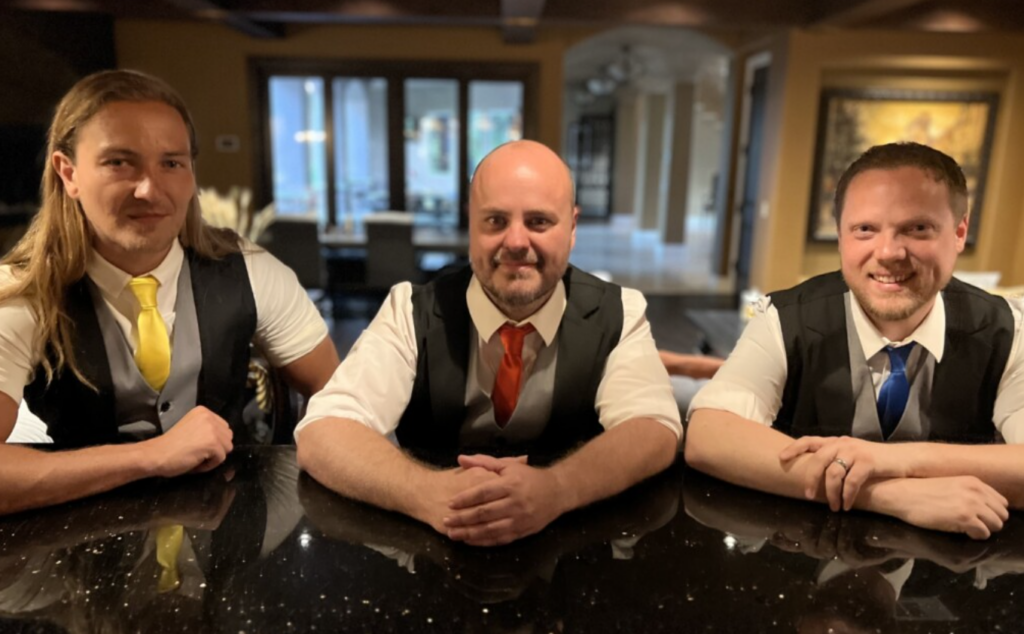Tim Story and Mark Mothersbaugh on how Moebius Strips reflects collaboration
The new collaborative project, Moebius Strips, was created by musician Tim Story as a way to honor his late friend, Dieter Moebius, of the bands Cluster and Harmonia.
Taking loops created by the late musician from an array of disparate sources, Story recomposed them into short pieces, and then sent them out to a cavalcade of collaborators to reinterpret them as they saw fit.
In addition to Moebius’ former bandmates Hans-Joachim Roedelius and Michael Rother, the project also sees reworkings by Mark Motherbaugh of Devo, Geoff Barrow of Portishead, Beak, and more. It’s a fascinating listen in which one can get lost for days.
This weekend, visitors to the Witching Hour Festival in Iowa City will be able to experience Moebius Strips as a live installation—with Story in attendance.
We spoke with Story and Mothersbaugh about their relationship to Dieter Moebius and the nature of collaboration.
The Pitch: This is such an amazing project. It connects all of these different musicians and it’s not just the music of Dieter Moebius, but there’s also Tim Story’s work in putting this all together and everyone else who is part of it. How did you come to be a part of this very intricate collection of artists?
Mark Mothersbaugh: I got a call from Tim, really. He knew that I had recorded at Conny Plank’s studio and that Moebius and [Hans-Joachim] Roedelius had come over to visit while I was there while Devo was recording in December of ’77 or, I think at the beginning of ’78. I can’t remember, but we were at Conny’s studio and I was very curious about them, you know?
The studio was interesting. I don’t know how much you know about it, but, but they did a lot of recording there and hung out for a couple of the days while we were recording.
I’m pretty sure Roedelius jammed with Devo for a while, ’cause cause Gerry [Casale] missed his flight and showed up a day late, so we spent the first day—we set up the drums and set up all the amps for recording, and then we just played with Bowie and Eno and Roedelius, for sure. I don’t know if maybe Moebius played. I can’t remember, ’cause I had just met him.
Holger Hiller was there and he was playing synths and told me a crazy story about how plants had been communicating with him lately and that he had just found out that he had that ability to communicate with plants when his friend was on German talk TV. He’s watching his listening to his friend talk, but then he’s getting distracted by a rubber plant that’s next to him on the set.
Through the TV, this rubber plant was trying to communicate with him. We were the only people–everybody else had left for lunch over to the main house. The recording studio was a converted pig sty and, so we were still sitting in the recording studio and he told me, and I was like, “Okay, well, here we are. We’re in an interesting part of Germany right now.” That was my first experience in Germany.
Moebius was around at that time and he used that studio a lot. I’m pretty sure that he was one of a group of German artists that were all there when Brian [Eno] took a loop of Indonesian singers to put on “Jocko Homo.”
Believe me: in the days before MIDI, people playing that kind of stuff was complicated. He cut this long piece of tape and shaved it down in length. It was about a 12-foot long loop and we all just made an “O” with our thumb and forefinger used that as a loop for the tape to go through so that it didn’t just sit in a heap at the bottom of the tape machine.
So Roedelius is there for sure and maybe Moebius, and we were all just standing, creating this human loop for the tape, and that was my introduction. I met Michael Rother [Neu!]. He had just finished a solo album, Flammende Herzen, which was excellent. I never released it, but I recorded versions of his songs and was influenced by that album for solo things I did and things I did in movies after that.
It was kind of a cool time. There’s a lot of creative people around when we were doing our first album, and that was my introduction to Moebius. Then we never met up again and then I got this call and was tickled that I got called. I was really enthusiastic about being part of it. It gave me an excuse to stop thinking about timecodes and films and intent and just concentrate. I just got to experience being a kid again, you know: taking stompboxes and running a drum machine and other instruments through it and doing things to accompany Moebius loops.
That sensibility seems so fascinating–the idea that you’re working with music by one person that is arranged by a second person, and then you get to put your stamp on it as well. How do you approach that musically? Do you just–as you say–go for that like childlike thing where you’re just hitting stompboxes?
Yeah. You know I’m lucky in that I started off in a band that was I thought we were an art movement. I didn’t think we were going to be a rock band, that’s for sure. Or being popular entertainment. I thought. I thought we were going to be art Devo. We had a political agenda and it was very critical of the way humans have mishandled planet earth and it has wasted resources here and damaged things—that we’re the unnatural species.
But, it was two sets of brothers, so I was used to collaboration. That’s why I enjoy scoring films is because I enjoy the collaborative process. The idea of the things getting handed from Moebius to Tim to me–I thought it just seemed like a very healthy way to work. I’m a believer that three heads are better than one.
Some of the other people that Tim Story chose to work on this Moebius Strips project are also in the film scoring business, like Geoff Barrow and Jean-Benoît Dunckel. You talked about how part of the appeal of doing this was getting out of the world of time codes. As you do a lot of scoring work, was part of the appeal that–while you’re working with someone else’s vision in both film scoring and this project–it seems like there’s a lot more freedom on this one?
You’re in a different zone, for sure, and that feels good in your brain, to be able to work from different corners. I like all kinds of scenarios and all kinds of collaborations and solo work. I write a lot of music. I come into to my recording studio–it’s really more of a writing studio, but it’s also a recording studio–down on Sunset Boulevard and on the Hollywood Strip and on the Sunset Strip a couple hours early every morning and I write music for myself and I write everything from beatnik poetry and square dance music to different kinds of instrumental music that I want to play and look and listen to in the background, in my own life. Instead of turning on the radio, I want to create the soundtrack that I’m listening to, writing songs.
I don’t have to have any limitations on it because I’m only collaborating with my own dreams and my own fears and my own frustrations from trying to maneuver through traffic and pay the bills every day. So once I get something totally different from that. I get to go to another place for a few hours and I’m lucky to get to do that. A lot of people don’t get to and I get to find that place every day. This, to me, it’s just another place.
I don’t even know how many TV shows or films that I’ve scored. I think I’ve scored about 75 films and a hundred TV shows or more. Maybe a dozen video games–and video games are a whole ‘nother place. Video games. You write music for them, and now they’re sophisticated. You compose music, but you’re thinking that people are going to listen to the first piece of music for 25 minutes, so you want it to be a great one. If it’s burnt into their brain and they have to go to bed thinking about it, it’s a good one.
Then, the second time they play the game, they have to listen to it for 19 minutes and then they started to figure it out, and when they finally get down to where they only listen to it for a minute. It’s in pieces and it’s in layers when you’re working on video games, so people hear it the way an artist writes it, almost. It becomes additive synthesis, all the gameplays, and it’s plastic. Depending upon when somebody achieves a goal on a level, more music keeps coming in to support that and to keep the excitement going and to know that you’re getting closer to the end of that level, for instance.
There are a lot of different ways to write music and to think about music, but this to me just felt like there were no strings attached to it other than it was Moebius and what’s greater than getting to be part of that and have a galaxy where Moebius is a big star?
The Pitch: How did you first come to meet Dieter Moebius?
Tim Story: I was friends with Hans-Joachim Roedelius from about 1983. I had just left my last real job–which was in a record store, actually–and I had a couple of releases of vinyl in Europe on a tiny label in Norway. The second one did pretty well. It got picked up by Polygram in Japan and I decided to quit my real job and see if I could make it work. I traveled to Europe for about three months and visited the label, visited a few journalists, but also looked up [Roedelius] and we hit it off and we remained friends for a long time.
About 20 years after that, I traveled with him a little bit for the first Cluster tour of the U.S. and that’s where I met [Moebius]. I’d always heard that he was maybe a little more difficult or something than Hans-Joachim, but it couldn’t have been farther from the truth.
I met him, I guess it was about ’96. We really enjoyed working together, which we didn’t really do for about five or six years, but whenever he traveled over here, he’d stop at our house we visited him in Majorca later and in his home in Berlin. It was just a friendship that developed that way over the course of about 20 years or so.
Is Moebius Strips an outgrowth of the work you did on The Cells? There are obviously similarities to it.
The main difference is that that I had access to material with both of them. In the case of Roedelius’ Cells, they came from about 10 years of piano recordings at my house here on my grand piano. This was while we were working on our collaborations, Joachim and I. They didn’t really go anywhere, but there were some really beautiful segments in there.
I was invited to do an interesting audio installation that I wanted to at the Toledo Museum of Art here and, as I began working on this material, that was sort of an “Aha!” moment: “This needs to be in a multi-track format.” So that was made up of tiny edits of 10 years’ worth of piano recordings.
Moebius Strips was different because I didn’t chop him up. I had access to a lot of his original recordings. Irena. his widow, and all of us and my wife–the four of us–were good friends and everything, so I had access to a lot of his raw material from the last 20 years, but I left them as they were for the most part.
I only did as small of tweaking as I could to them because I wanted people to be able to hear his original sounds in his original loops, but not just as a tribute album, or as a remixed kind of thing, but really allow people to hear how he heard and how he built his sound universe out of the most disparate elements.
I mean, there’s everything from traditional synthesizers and samples of the craziest stuff that he liked listening to: door squeaks and industrial machines, found sounds, and a lot of music in there. So, yeah, they both have some similar themes, like how the mind creates composition first and then how listeners’ minds create compositions by the events that they hear around them all the time. There’s definite parallels and there are some definite differences.
It’s interesting because you said there that the listeners’ minds create compositions and now you have some collaborators and guests on this album, which seems to be a way of taking the listeners hearing compositions and having them actually get to create what they hear.
Yeah, exactly. I mean, this was Moebius, who never followed rules, really. He wasn’t interested in any sorts of rules. He was, in a way, a punk, a dada. He was was proudly non-musician and so partly, the thing that struck me as I began to think about this project was that he created music primarily by listening. He would find sounds that he would like, and he would find really unlikely ways to put them together. He couldn’t sit at a keyboard and play keyboard compositions. He really had no patience for that. He really sort of pushed that away because he was so tired of that sort of traditional thinking about music.
He loved to put sound together this way and it was wonderful to bring these contributors together with Moebius’ sounds which I recombined into these new compositions, but basically left the elements alone. A lot of his elements were short. He cut his loops into such strange conglomerations, but they were beautiful. If you sat and listened to them, you would realize what he found in them.
I recomposed his loops and then we gave those re-compositions to a layer of fantastic contributors. They were people that either worked with Moebius, like Michael Rother and Hans-Joachim Roedelius and a younger generation that have been very, very influenced by their work–especially Cluster’s –like Jean-Benoît Dunckel from Air and Jeff Barrow from Portishead, and even much younger artists like Eve Maret and Sarah Davachi, who really didn’t know him until this project but in a lot of ways were inspired in their early careers from some of this music.
It was a way to honor Moebius’ love to collaborate. I know over half of his recordings were collaboration, so the idea was to sort of push that narrative forward and further confuse the authorship of this, as well. I mean, Moebius created all the sounds. I put them together. I give them yet to another person who adds their creativity and compositions in sounds and what we end up with is–I don’t know, but it was done with a great deal of love and I think there’s a real purity in it, even though so many people had their hands in these pieces along the way, I am really very happy with the way that they honored Moby’s sounds and also were eager to collaborate with that in their own style.
Now there is going to be a further layer of blurring that sense of authorship, because there’s going to be a live installation. What will that installation look and sound like before participants start taking part?
That’s a perfect way to put it because that’s the full circle. We bring it back to the listener to make the final decision, the final journey. No two people that are in there will ever hear the same thing, which I love. I love the fact that you could exist in this thing for a hundred years and never hear the same thing unless you stood in exactly the same place and didn’t move, didn’t ever turn your head, or take a step.
It’s an array. It’s a relatively simple idea. It’s an array of eight speakers in a circular array. They all point to, to a center point and each of Moebius’ layers and the layers of our contributors are preserved on individual monitors so that these compositions can sort of be decomposed. You can walk over and hear just a pure Moebius loop coming out of one thing and as you move across, you hear that blend with another layer, which might be another layer of Moebius’, which I overlaid together to make these basic compositions, or they could be the layers of our contributors, which are also kept individually.
It allows people really to hear the compositional process. It’s a very artificial process in this case because instead of performing drums, and then a bassline, and then keyboards, and then the singer, these were made from pure samples of Moebius’ music and I layered these together and then we have this wonderful layer of layers of contributions, which also create these compositions. It encourages people to hear these compositions as the parts coming together able to control the parts that they hear by the way they move around.
I think of it sometimes as if—you go up to a monitor or one of the speakers and really hear mostly just what’s coming out of there, it’s akin to standing too close to an impressionist painting or a video screen where you just see moving pixels, but it becomes very abstract. Then you step back and you realize how much your mind is always trying to make order out of chaos. At some point, it clicks and you go, “Oh yeah, that’s a picture.” This is a little bit like that. We really encourage people to hear the relatively abstract bits that make up these compositions, which they can hear the way I hear it by standing exactly in the middle, but we allowed them to be the final composer, really, of these things by the way they move around in the space.
Moebius Strips is out now as an album, and can be experienced this weekend at the Witching Hour Festival in Iowa City from November 5-6. Details on that event here.







